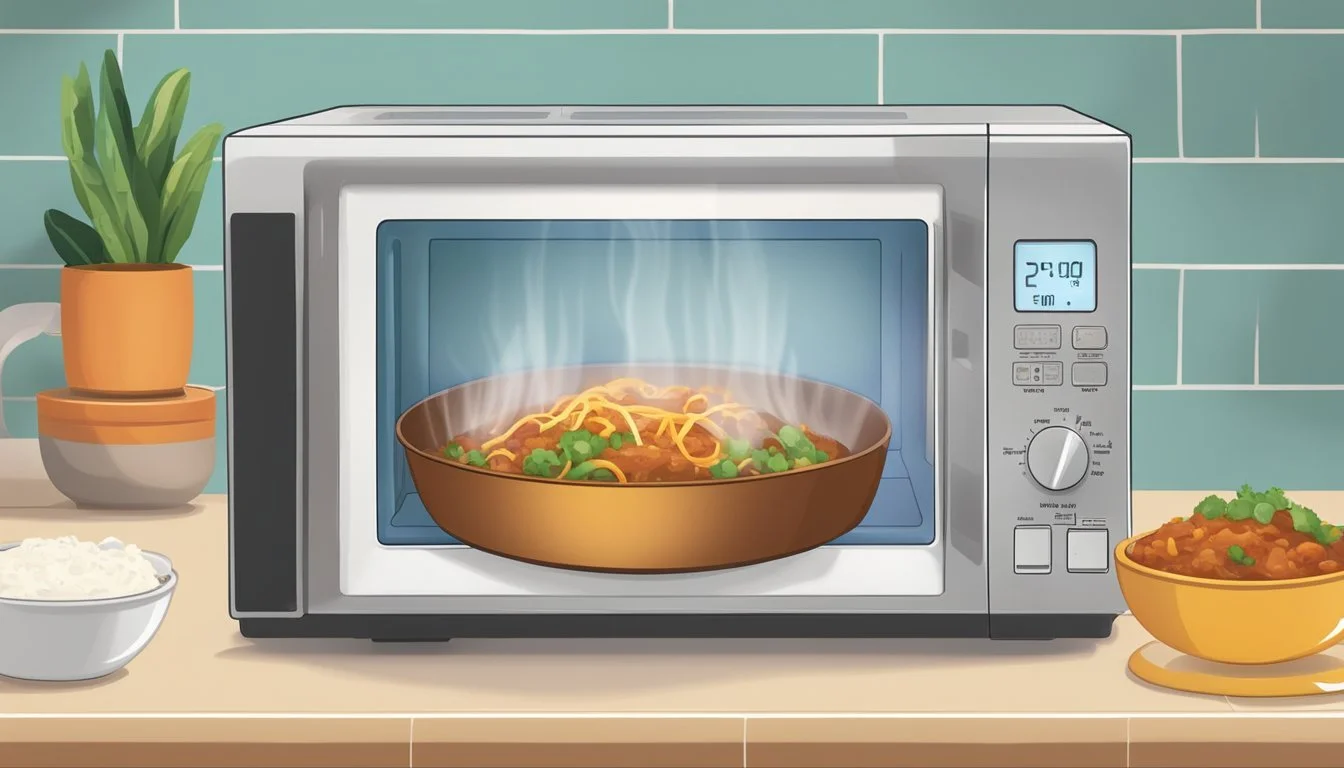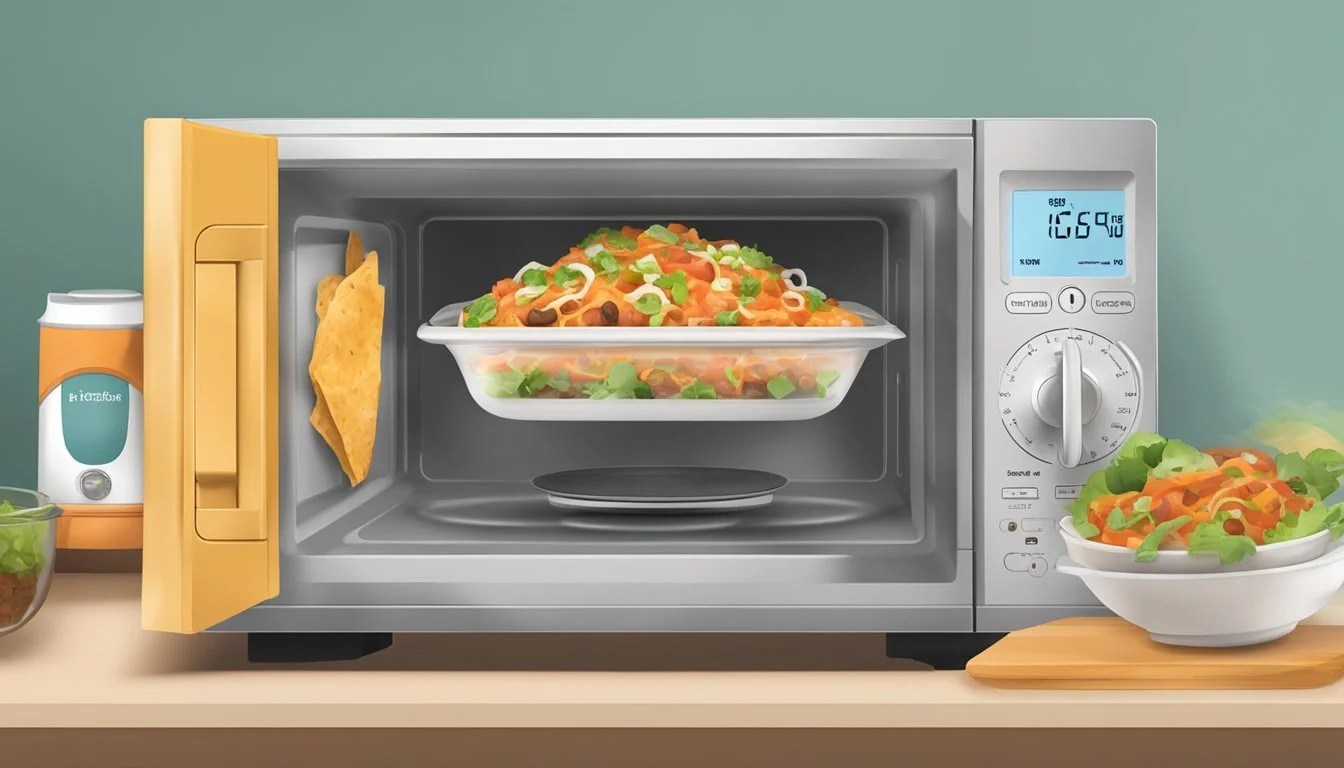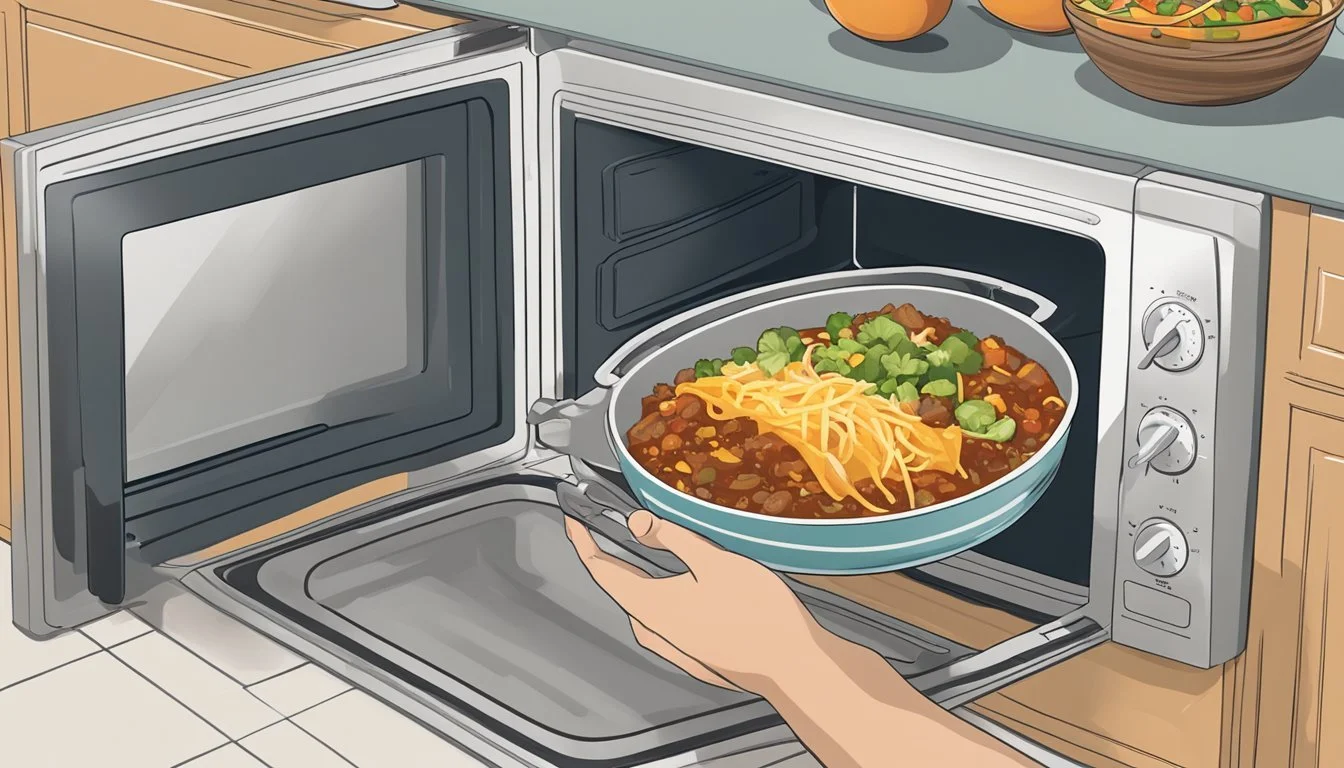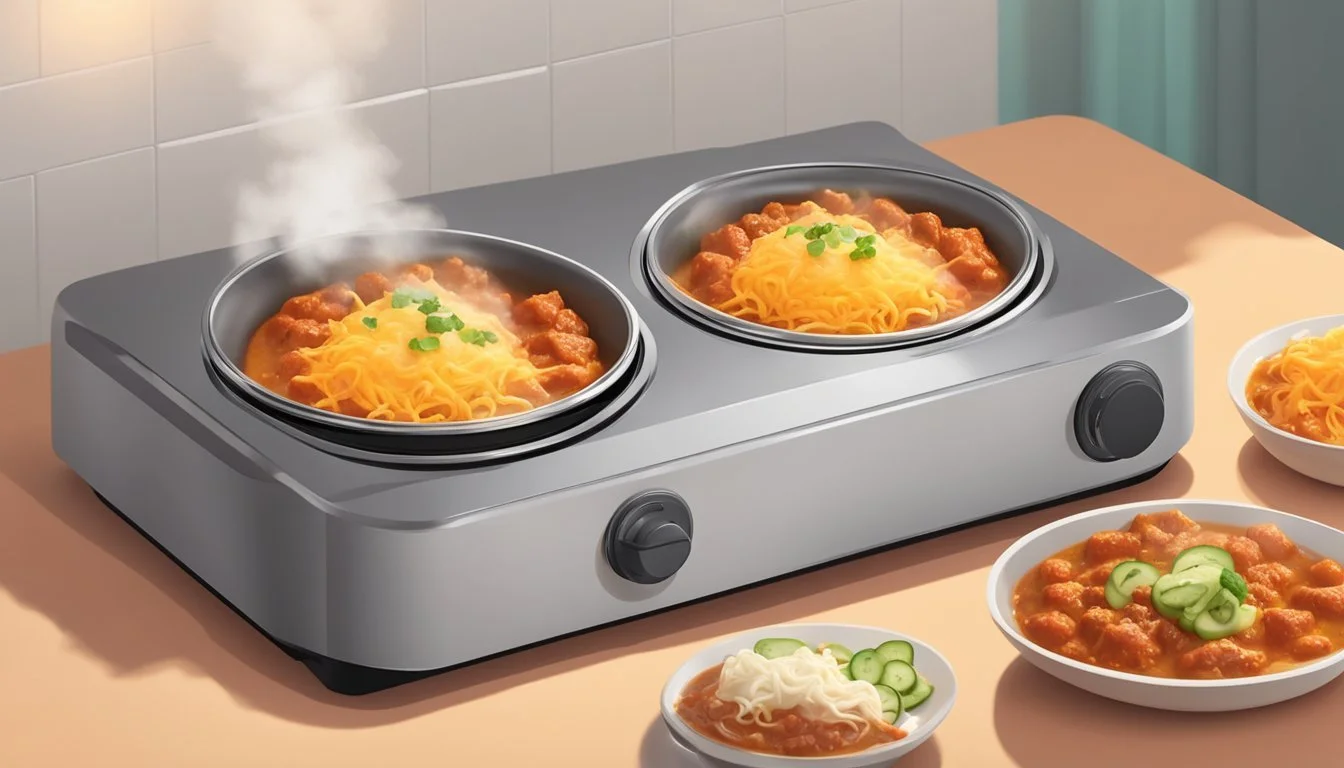How to Reheat Beef Enchilada Bowls
Best Methods Explained
Reheating beef enchilada bowls can be a breeze if you follow a few simple steps, ensuring that your meal retains its flavor and texture. Whether you're using an oven, microwave, skillet, or even a toaster oven, each method offers a quick and effective way to enjoy your leftover enchiladas.
For the best results, preheat your oven to 350°F (175°C), place the enchiladas in an oven-safe dish, and heat for about 15-20 minutes, making sure to check periodically for the desired warmth. If you prefer using a microwave, unwrap the enchilada, place it on a microwave-safe plate, cover with a splatter guard, and microwave on high for 2 minutes. For crispier tortillas, heating the enchiladas in a skillet with a small amount of oil on medium-high heat for 2-4 minutes can also achieve great results.
Each method has its advantages, from the convenience of a microwave to the crispy texture achieved in a skillet. These varied techniques allow you to reheat your beef enchilada bowls in a way that best suits your preference, ensuring a delicious, warm meal every time.
Understanding Enchiladas
Beef enchiladas bowls consist of key components that together create a rich and filling dish. The method used to reheat these components significantly affects their taste and texture.
Components of Beef Enchiladas
Beef enchiladas are made up of tortillas, a savory beef filling, cheese, and sauce.
Tortilla: Typically made from corn or flour, the tortilla serves as the base, wrapping around the filling.
Filling: Ground beef is commonly sautéed with spices such as cumin, chili powder, and garlic, adding a robust flavor.
Cheese: Melted cheese, both inside and on top, enhances the dish’s richness.
Sauce: Red or green enchilada sauce, often made from chili peppers and tomatoes, adds moisture and additional flavor.
Each ingredient contributes to the overall experience, making it crucial to understand their role in the dish.
Importance of Reheating Method on Texture and Flavor
The reheating process impacts both the texture and flavor of beef enchilada bowls. Ensuring even heating preserves the texture of the tortillas, prevents the beef filling from becoming dry, and keeps the cheese gooey and melted.
Oven: Best for maintaining texture and flavor, heating enchiladas at 350°F until warm.
Skillet: A small amount of oil helps crisp the bottom while covering and adding water steams the enchiladas, preserving moisture.
Microwave: Quick but risks uneven heating and soggy tortillas. Cutting the enchiladas and poking holes can help distribute heat better.
Toaster Oven: Similar to a regular oven, but faster and convenient for smaller portions.
Reheating correctly ensures that the tortillas remain soft yet firm, the beef filling stays juicy, and the cheese melts perfectly.
Pre-Reheating Considerations
Proper handling of beef enchiladas before reheating is crucial to maintaining both their flavor and safety. Key aspects include effective storage methods and a careful pre-reheating check.
Storing Enchiladas Properly
To ensure beef enchiladas stay fresh, they should be stored correctly. Use airtight containers to lock in moisture and prevent contamination. Cover the enchiladas well with plastic wrap or aluminum foil if opting for less durable storage methods.
Refrigerators are ideal for short-term storage, keeping enchiladas safe to consume for 3-4 days. For longer storage, freezing is recommended. Ensure the enchiladas are packed tightly and labeled with the date of storage. When ready to use, proper defrosting—such as leaving them in the refrigerator overnight—prevents texture and flavor loss.
Checking Enchiladas Before Reheating
Before reheating, inspect the enchiladas for any signs of spoilage. Look for unusual odors, discoloration, or a slimy texture as these may indicate bacteria growth.
If the enchiladas were frozen, ensure they are completely thawed for even reheating. For measured safety, use a food thermometer to confirm the internal temperature reaches at least 165°F during reheating.
Checking these conditions helps ensure the dish remains both safe and delicious.
Reheating Beef Enchiladas in the Oven
To ensure beef enchiladas remain flavorful and moist, reheating them in an oven is a reliable method. This approach helps maintain their texture while evenly heating through.
Oven Reheating Steps
1. Preheat the Oven: Set your conventional oven to 350°F (175°C). Allow it to fully preheat to ensure even cooking.
2. Prepare the Dish: Place the beef enchiladas in an oven-safe baking dish or casserole dish. Arrange them in a single layer for uniform heating.
3. Cover with Foil: To prevent the enchiladas from drying out, cover the dish with aluminum foil. This traps moisture and ensures tender enchiladas.
4. Bake: Place the covered dish in the oven. Bake for approximately 20-25 minutes. Cooking time may vary based on the thickness of the enchiladas or if they were previously frozen.
5. Check Temperature: Use a food thermometer to ensure the internal temperature reaches at least 165°F (74°C), ensuring the beef is heated through.
Tips for Keeping Enchiladas Moist
1. Add Extra Sauce: Pour some additional enchilada sauce over the top before covering with foil. This keeps them moist and enhances flavor.
2. Use Parchment Paper: Alternatively, place a piece of parchment paper between the enchiladas and the aluminum foil to prevent sticking and allow some steam to escape.
3. Monitor Baking Time: Avoid over-baking by checking the enchiladas frequently. Overcooking can result in dry, tough enchiladas.
4. Middle Shelf: Use the middle oven rack to ensure even heat distribution. This helps maintain an even warm-up process.
Adhering to these tips helps ensure that reheated beef enchiladas are just as delicious as when they were first made.
Alternative Reheating Techniques
Reheating beef enchilada bowls can be done effectively using several methods to retain their flavor and texture. Here are details on using a skillet, toaster oven, and air fryer to warm your meal properly.
Using a Skillet for Reheating Enchiladas
The skillet method allows for a quick and efficient way to reheat beef enchiladas while maintaining some crispiness. To use this method:
Add a small amount of oil to a skillet and heat it on medium-high.
Place the enchiladas in a single layer.
Heat for 2-4 minutes to crisp the bottom of the tortillas.
Add a few drops of water around the enchiladas.
Cover the skillet with a lid to steam them and heat the filling.
This method brings out the flavors while avoiding a soggy texture.
Toaster Oven Reheating Method
The toaster oven provides a balanced way to reheat enchiladas. Here’s how to do it:
Preheat the toaster oven to 350°F (175°C).
Place the enchiladas in a toaster oven-safe baking dish.
Heat for 15-20 minutes, checking periodically.
Optionally, add some additional enchilada sauce before the last 5 minutes.
Using a toaster oven helps achieve a consistent temperature throughout, making the enchiladas warm and delicious without overcooking.
Warming Enchiladas in an Air Fryer
Using an air fryer offers a way to reheat beef enchiladas that keeps them crispy. Follow these steps:
Preheat the air fryer to 350°F.
Place the enchiladas in the air fryer basket in a single layer.
Heat for 3-5 minutes.
Check halfway to ensure even warming.
The air fryer method is excellent for achieving a crispy tortilla while ensuring the filling is hot.
Enhancing Leftover Enchiladas
Transforming leftover enchiladas into a delightful meal is about combining fresh toppings with complementary sides. These enhancements can elevate your dining experience and bring new life to your dish.
Adding Freshness with Toppings and Sides
To revitalize the texture and flavor of leftover enchiladas, consider adding fresh toppings like chopped cilantro, sour cream, or shredded cheese. Chopped, fresh vegetables such as tomatoes, onions, or jalapeños can add a crunchy contrast.
Pair the enchiladas with sides like rice or refried beans to create a more fulfilling meal. These sides complement the enchiladas and contribute to a balanced taste profile. For an additional burst of flavor, serve with a squeeze of lime and a side of guacamole or salsa.
Post-Reheating Advice
Reheating beef enchilada bowls successfully involves ensuring proper food safety and enhancing the meal's presentation.
Ensuring Proper Food Safety
To avoid foodborne illnesses, reheated beef enchilada bowls must reach an internal temperature of 165°F (74°C). Always use a food thermometer to check this. Never leave reheated enchiladas at room temperature for more than two hours.
If using a microwave, stir the ingredients halfway through the reheating process to ensure even heating. For oven reheating, cover the dish with aluminum foil to prevent it from drying out.
When reheating different types of enchiladas such as chicken or pork, similar temperature guidelines apply. These precautions ensure your meal remains safe and delicious.
Serving and Presentation Tips
Enhance the visual appeal of your beef enchilada bowls by adding fresh garnishes. Options include chopped cilantro, diced onions, and shredded cheese. For additional flavor, provide sides like guacamole, sour cream, or salsa.
Serve the enchiladas in pre-warmed bowls to maintain heat longer. Complement them with a fresh salad or Mexican rice to create a balanced meal.
For a luxurious touch—sprinkle some crispy tortilla strips on top. This adds a satisfying crunch and enhances the dish's texture. Following these tips will improve both the taste and appearance of your reheated enchiladas.
Conclusion
Reheating beef enchilada bowls can be done efficiently with the correct methods.
Use the oven to retain flavor. Preheat to 350°F, cover with aluminum foil, and bake for 20-25 minutes until heated through. For added crispiness, uncover for the last 5 minutes.
The microwave is quicker. Place enchiladas in a microwave-safe dish, cover, and heat on medium power for 2-3 minutes, checking halfway through.
For a skillet, add a little oil and heat on medium-high. Arrange enchiladas in a single layer, cooking for 2-4 minutes to crisp the bottom. Add a few drops of water, cover, and cook until heated.
Each method has its pros and cons. The oven method helps maintain texture and flavor, the microwave is faster, and the skillet adds a crisp texture.
By following these steps, beef enchilada bowls can be enjoyed as if freshly made, whether for a quick meal or a Tex-Mex fiesta.









